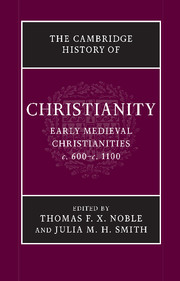Book contents
- Frontmatter
- Introduction: Christendom, c. 600
- Part I Foundations: Peoples, Places, and Traditions
- Part II Christianity in Confrontation
- Part III Christianity in the Social and Political Order
- Part IV Christianity as Lived Experience
- 18 Birth and death
- 19 Remedies for sins
- 20 Sickness and healing
- 21 Gender and the body
- 22 Sacrifice, gifts, and prayers in Latin Christianity
- 23 Performing the liturgy
- Part V Christianity: Books and Ideas
- Conclusion: Christendom, c. 1100
- Bibliographies
- Index
- References
20 - Sickness and healing
from Part IV - Christianity as Lived Experience
Published online by Cambridge University Press: 28 March 2010
- Frontmatter
- Introduction: Christendom, c. 600
- Part I Foundations: Peoples, Places, and Traditions
- Part II Christianity in Confrontation
- Part III Christianity in the Social and Political Order
- Part IV Christianity as Lived Experience
- 18 Birth and death
- 19 Remedies for sins
- 20 Sickness and healing
- 21 Gender and the body
- 22 Sacrifice, gifts, and prayers in Latin Christianity
- 23 Performing the liturgy
- Part V Christianity: Books and Ideas
- Conclusion: Christendom, c. 1100
- Bibliographies
- Index
- References
Summary
Saints and others
In early medieval Basra (Iraq), a story circulated about a handsome deacon with a speech impediment. Sorcerers were blamed for his eight years’ suffering:
His mother took him round to a monastery to be healed, but he received no healing, either from the monastery, or from anyone else. So she went off to the doctors, followers of Plato, but she received no help from Plato or his followers. So she set off on a journey … to some sorcerers, she [got] nothing either from them or from the wicked whom the demons had deceived.
Finally, she heard about a visiting holy man, John of Dailam. The outcome can be guessed. Merely laying his cross on the deacon’s tongue, the saint triumphed where others – monks, doctors, “witch doctors” – had failed. (The doctors, as purveyors of philosophical medicine, were supposedly followers of Plato; more realistically they were disciples of Galen.) The following Sunday, to universal astonishment, the deacon read the Epistles in church.
Such was the miracle story included in a panegyric of John. Composed well after his death in the early eighth century, it apparently incorporates material from his own time. In England, much later on, a similar tale was told of a girl who suffered for two years from an ulcer on each foot. “She endured such great pain and swelling that … she could not touch the ground with either foot.” Her father carried her about among “doctors and holy places” – living physicians and dead saints.
- Type
- Chapter
- Information
- The Cambridge History of Christianity , pp. 416 - 432Publisher: Cambridge University PressPrint publication year: 2008
References
- 1
- Cited by



